Navigating Portfolios Through Unchartered Waters
In times of market uncertainty when navigating portfolios , investors often turn to sayings such as “those who fail to learn from history are doomed to repeat it” and “history never repeats itself, but it does often rhyme.” When it comes to the day-to-day headlines, both quotes are relevant given the long history of unique economic events and resulting market corrections and crashes.
This is because investors must deal with innumerable economic and market surges and challenges over the course of their financial lives. In just the last few years, portfolios and retirement plans have been greatly tested by the pandemic, the highest inflation rates since the ‘80s, rising interest rates, the Russia/Ukraine war, political uncertainty, asset bubbles, swelling US Debt, swiftly shifting Fed monetary policy, and much more. Even through times when the waters are calm and markets are steadily rising like the tide, including from 2009 to 2020, investors and headlines always find reasons to be worried.
While it’s important to understand the individual issues, it’s perhaps more important to maintain a broader perspective based on the lessons of history and not rush to take any swift actions in the short run that can derail a multi-decade retirement. There is not a marine radar device that can help see or predict the next upcoming black swan financial event, which is why we encourage investors to utilize methods of diversification and asset allocation to help weather storms and work to minimize volatility as well as sea-sickness.
No Free Lunch
“The good seaman weathers the storm he cannot avoid, and avoids the storm he cannot weather.” – Unknown
Jon here. As your financial Captain, consider that great wealth is built slowly over months and years, like a 226-ton, slow moving transatlantic cruise ship continually crossing the ocean by disciplined investors. While history hardly repeats itself, investor behavior studies continually illustrate that many individuals greatly underperform their own target investment goals due to market timing and jump overboard at exactly the wrong time.
Consider the maxim that ‘there is no such thing as a free lunch’ (TINSTAFL) when selecting alternative products to traditional stocks and bonds to lock in today’s interest rates or utilized as a hedge to market volatility. Just remember, if it sounds too good to be true, it usually is.
Instead of maintaining a low cost, diversified, liquid portfolio, many anxious or impatient investors are reaching for the highest returning or yielding alternative or structured product, limited partnership, crypto, fixed or indexed annuity, or other unique hedging strategy, while ignoring baked-in risks from liquidity and sector/product risks to actual loss of principal.
It always seems like investment companies roll out highly focused offerings at exactly the wrong time. Examples may include the crypto marketing frenzy, hyped in part by athletes and celebrities with fund offerings blowing up from a mere few funds to nearly 30 by the end of 2021.That was just in time for the 2022 crypto correction, when the CMBI Bitcoin Index was down near two thirds of its value.
On the other side of the coin, being too cautious can provide other challenges to help keep up with inflation and taxes over time while developing retirement income, even if your cold hard cash is FDIC insured at your bank. Consider a 4.8% 5-year CD or fixed annuity may renew for nearly half of that rate as CPI cools off over time. Too-boot you may end up missing out on the market recovery going into the next bull market.
Navigating Through Black Swan Events
“Boats in the harbor are safe but that is not what they are meant for.” – Zig Ziglar
Of the various challenges investors face today, the banking crisis was perhaps the biggest unforeseen black-swan event. It’s now clear that FDIC-insured banks hold treasury bonds that are worth hundreds of billions less due to rising interest rates. Banks such as Silicon Valley Bank and Signature Bank had customers concentrated in specific industries, such as tech and crypto, that made them susceptible to liquidity problems and bank runs.
The reality is that the banking crisis will take time to play out. Although modern investors are accustomed to a rapid news cycle, it often takes time for cracks to form, problems to be identified, events to play out, solutions to be implemented, and finally for the system to stabilize.
Many historical examples underscore this. During the global financial crisis for instance, the housing market had already begun to falter by 2006. Bear Stearns failed in March 2008, but the Lehman collapse didn’t occur until September. During the 1998 Asian currency crisis, the first signs of trouble occurred with Thailand in July 1997. The hedge fund Long-Term Capital Management wasn’t bailed out until September the following year. In some ways, the COVID-19 pandemic is the exception given how quickly it reached the U.S. and induced an economic lockdown, but it’s also the case that three years later, we are still experiencing aftershocks and problems.
Optimism For Recovery
“The pessimist complains about the wind; the optimist expects it to change; the realist adjusts the sails.” – William Arthur Ward
There are always reasons to be on the edge of one’s seat. However, there are reasons for optimism too. The market, economy, and the financial system have been more resilient so far in 2023 than many expected. The job market has been surprisingly strong despite layoffs in tech. Inflation has improved markedly across key areas such as energy and goods. Interest rates rose swiftly early in 2021 and throughout 2022 but have stabilized more recently with the 10-year Treasury yield ending the first quarter at 3.47%. Even the stock market has improved with the S&P 500 having gained 7.6% and 7.5% across the last two quarters.
History shows that markets often turn around when investors least expect it. To put it more strongly, long-term investors are often rewarded when navigating portfolios precisely because they are willing to accept and manage risk when others are not.
Charts To Navigate Recovery
“He who loves practice without theory or strategy, is like the sailor who boards ship without a rudder and compass and never knows where he may cast.” – Leonardo da Vinci. Below, we highlight five important insights to guide investors through the coming months.
1 Regional bank stocks have struggled as financial conditions have tightened
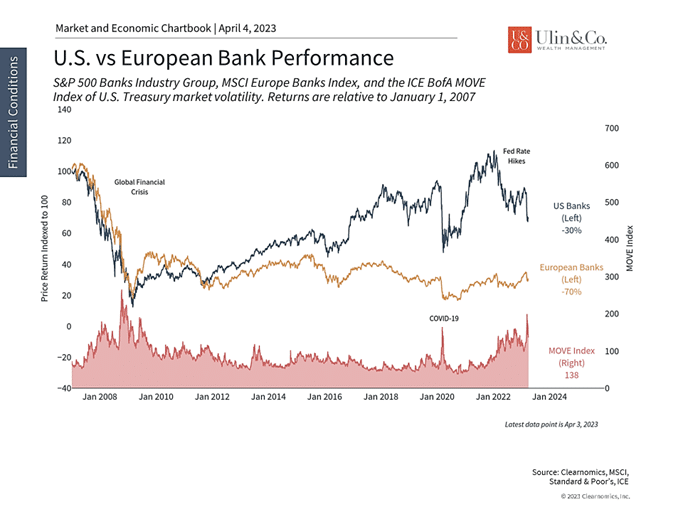
It’s no surprise that bank stocks have struggled across markets. In the U.S., this is due to regional banks as the crisis that began with Silicon Valley Bank and Signature Bank plays out. The FDIC, Treasury Department, and the Fed have stepped in to stabilize the system, as have their European counterparts.
The accompanying chart shows the performance of U.S. and European banks. Perhaps most striking, however, is that the MOVE index of bond market volatility jumped to its highest level since the 2008 financial crisis. Fortunately, the situation has stabilized as the initial bank run has calmed. Ironically, this has allowed interest rates to fall which will likely reduce the unrealized bond losses at banks that helped create this situation in the first place.
While there are specific circumstances underlying each of these bank failures, financial instability tends to occur when monetary policy and credit conditions tighten. This is partly because many banks had grown accustomed to high levels of liquidity supporting deposits and their aggressive customer acquisition practices. Thus, it will take time for the banking system to stabilize as the world adjusts to tighter financial conditions.
2 Balanced portfolios have benefited from both stocks and bonds this year
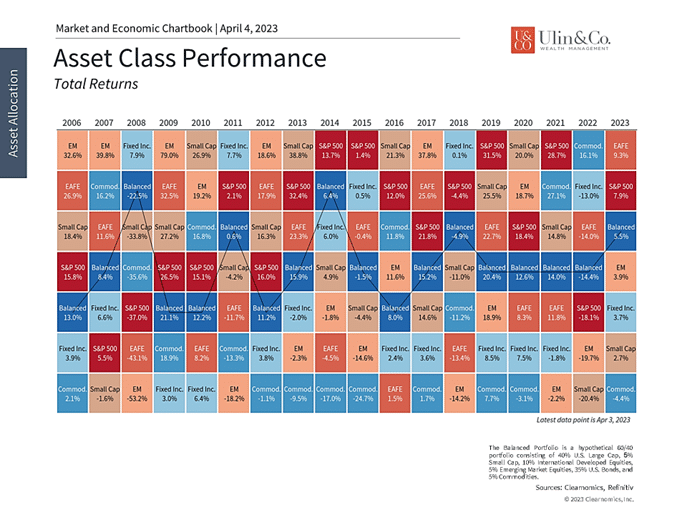
Although only a quarter has passed, markets are already performing much better than last year. This is because interest rates have been more stable and inflation has improved, supporting both stocks and bonds this year. You can see on the chart above that the S&P 500 index has been hovering near 7% (4.3.23 YTD). A hypothetical 60/40 portfolio generated near 5.1% (gross) over this same period, underscoring the continued importance of diversification and long-term thinking.
3 Financials have struggled but tech-related sectors have rebounded
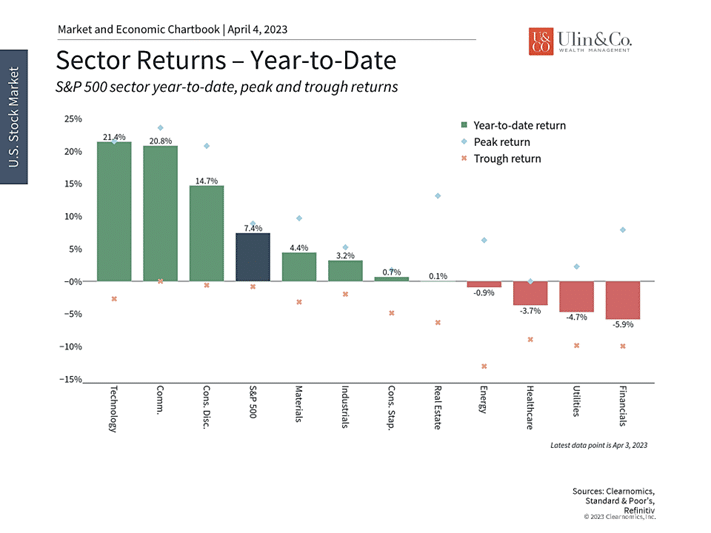
While the S&P 500 Financials sector has struggled due to financial stability concerns, many other sectors have offset it. The Information Technology, Communication Services and Consumer Discretionary sectors have rebounded from last year’s losses as interest rates have fallen and the economy has grown more resiliently than expected. Similarly, the Nasdaq gained 17% with dividends in the first quarter. While investors should not focus too much on only three months of returns, this is a reminder of how quickly market sentiment can shift and of the importance of staying diversified across sectors.
4 The Fed is expected to slow its pace of rate hikes or to cut rates
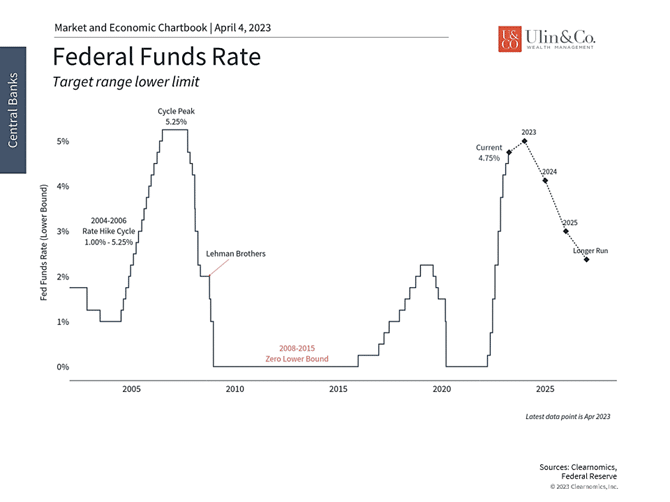
The Fed chose to raise rates despite the ongoing banking crisis, in part as a message about their confidence in the financial system. The Fed’s latest projections show that officials expect to keep rates high through the rest of 2023. This is in stark contrast with fed funds futures which show implied rate cuts later this year. Either way, this suggests that the Fed is near the end of its rate hike cycle after one of the sharpest jumps in policy rates in history.
5 It’s important to stay invested and take advantage of attractive valuations
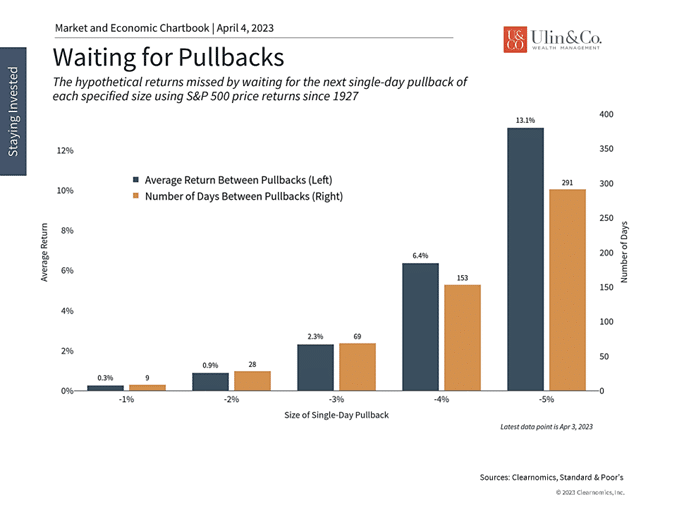
Ultimately, investors should focus on the long run and not overreact to daily headlines. In particular, valuations are still the most attractive in years as investor sentiment slowly improves. The accompanying chart highlights that staying invested, or taking advantage of better market levels, is often rewarded. History shows that waiting for the next pullback often results in missed opportunities both in terms of returns and the length of time investors need to wait.
The bottom line? Developing and managing a portfolio and retirement income strategy that can help get you through decades takes time, patience, and ongoing planning. While there are ongoing challenges when navigating portfolios through unchartered water,staying focused and holding diversified portfolios is still the best way to achieve long-term financial goals.
For more information on our firm or to request a complementary investment and retirement check-up with Jon W. Ulin, CFP®, please call us at (561) 210-7887 or email jon.ulin@ulinwealth.com. Get Started Today: Contact Us Below
Note: Diversification does not ensure a profit or guarantee against loss. You cannot invest directly in an index.
Information provided on tax and estate planning is not intended to be a substitute for specific individualized tax or legal advice. We suggest that you discuss your specific situation with a qualified tax or legal advisor. Navigating Portfolios
You cannot invest directly in an index. Past performance is no guarantee of future returns. Diversification does not ensure a profit or guarantee against loss. All examples and charts shown are hypothetical used for illustrative purposes only and do not represent any actual investment. The information given herein is taken from sources that IFP Advisors, LLC, dba Independent Financial Partners (IFP), and it advisors believe to be reliable, but it is not guaranteed by us as to accuracy or completeness. This is for informational purposes only and in no event should be construed as an offer to sell or solicitation of an offer to buy any securities or products. Please consult your tax and/or legal advisor before implementing any tax and/or legal related strategies mentioned in this publication as IFP does not provide tax and/or legal advice. Opinions expressed are subject to change without notice and do not take into account the particular investment objectives, financial situation, or needs of individual investors.




